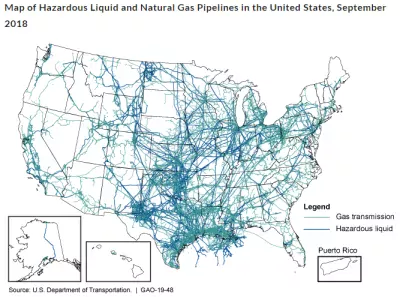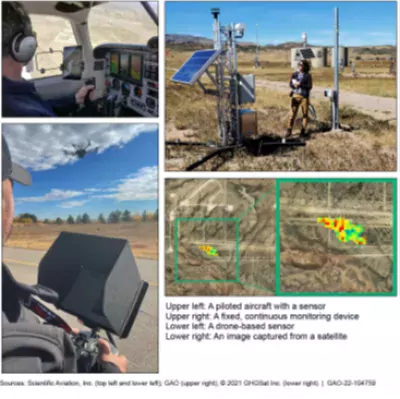Fossil and Alternative Fuels
Issue Summary
The United States is the largest producer of fossil and alternative fuels in the world. The federal government manages and oversees a number of activities related to these industries, including oil and gas development on federal lands and waters, petroleum refining, oil and natural gas transportation, and federal biofuels requirements.
But federal agencies could improve how they manage and oversee these activities.
For instance:
- The Department of the Interior’s (Interior) management of federal oil and gas resources is on the High Risk list due to challenges with revenue determination and collection, and human capital. Three priority recommendations in 2023 to Interior also involved improving oversight of offshore oil and gas activities. For example, royalties that companies pay on the sale of oil and natural gas extracted from leased federal lands and waters constitute a significant source of revenue for the federal government. However, Interior may not be collecting all of the royalties that oil and gas companies owe the federal government. Interior’s Office of Natural Resources Revenue could better ensure the accuracy of royalty payments from companies with federal leases.
- Interior’s Bureau of Safety and Environmental Enforcement (BSEE) helps manage oil and gas production offshore in federal waters. BSEE has allowed the offshore oil and gas industry to leave 97% of pipelines (18,000 miles) on the seafloor when no longer in use. Pipelines can contain oil or gas if not properly cleaned in decommissioning, but the bureau doesn't ensure that standards, like cleaning and burial, are met.
- Offshore oil and gas infrastructure faces significant and increasing cybersecurity risks in the form of threat actors, vulnerabilities, and potential impacts—including physical, environmental, and economic harm. For example, the 2021 cybersecurity attack on the Colonial Pipeline Company caused a temporary disruption in the delivery of gasoline and other petroleum products across much of the southeast United States—and highlights the urgent need to address long-standing cybersecurity challenges. BSEE has long recognized the need to address cybersecurity risks but has taken few actions to do so.
Image

- To reduce aviation greenhouse gas emissions, the White House challenged agencies to increase production of sustainable jet fuel to 100% of commercial demand by 2050. The Departments of Transportation, Energy, and Agriculture have created a roadmap to guide their efforts to support such an increase in sustainable jet fuel but haven’t established how they will track progress.
- In 2010, in response to the Deepwater Horizon oil spill in the Gulf of Mexico, responders applied chemical dispersants at the wellhead more than 1,500 meters below the surface. Subsurface use of dispersants was unprecedented and controversial; however, more than a decade later, the risks and effectiveness of such use of dispersants on the environment and human health still are not well understood by the agencies that must decide how to respond to any future spills—the Coast Guard and the Environmental Protection Agency (EPA)
- In 2019, about 39% of U.S. natural gas exports went through export facilities—in which the gas is liquefied and loaded onto ships for transport. Multiple federal agencies regulate export facility design. Federal guidance says that agencies should review regulations every 3-5 years and adopt necessary technical standards for safety and environmental protection. But some regulations haven't been updated.
- To help reduce greenhouse gas emissions, the Renewable Fuel Standard requires that U.S. transportation fuels contain 36 billion gallons of renewable fuels by 2022. However, the nation will likely not meet the emissions goals set for it through 2022, largely because advanced biofuels—which reduce emissions more effectively—haven't been produced as expected.
- The Strategic Petroleum Reserve, managed by the Department of Energy (DOE), exists to minimize the effects of disruptions in the supply of petroleum products. As of March 2018, it held about 665 million barrels of crude oil. However, a review by DOE didn't determine an optimal size for the reserve, and did not fully consider factors like changes in current and future market conditions.
- Industry is voluntarily taking actions to reduce methane emissions, such as using aircraft and satellites to detect emissions, in addition to handheld devices required by EPA. However, few oil and gas operators have applied to EPA for approval to use alternative technologies. Some industry representatives said they experienced challenges in meeting EPA’s requirements, including that site-specific applications are time- and resource intensive.
Technologies Used to Detect Methane Emissions from Oil and Gas Development
Image


